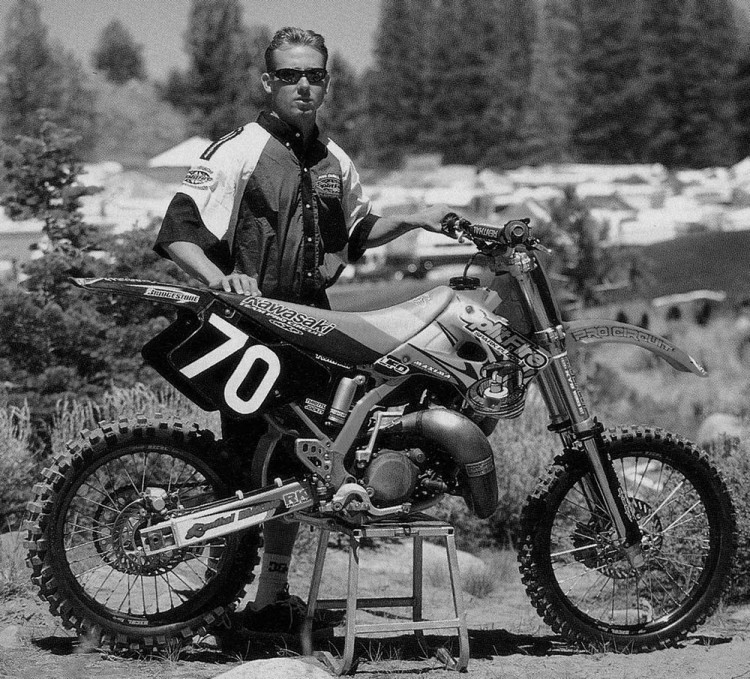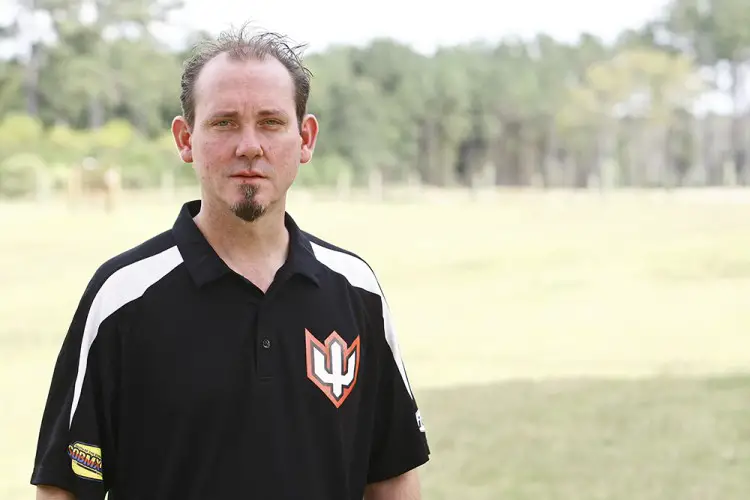INTERVIEW OF THE WEEK: CHAD WATTS
Last Friday I ventured down to South of the Border MX in Hamer, South Carolina, to test a ridiculously trick Yamaha YZ125 two-stroke owned by ICW’s Brett Koufas (you’ll learn more about that in the Mid-Week Report). Little did I know that Chad Watts, multi-time championship-winning mechanic and owner of Watts Perfections, would be involved in the project. For those who followed motocross in the 1990s, Chad Watts will be remembered as one of the elite wrenches in the business. After stints with Ryan Hughes and Mickael Pichon, Watts began wrenching for a young red-head by the name of Ricky Carmichael at the end of 1996. The rest, they say, is history.
Chad Watts resigned from factory Honda in the middle of 2003, moved back to his hometown of Shelby, North Carolina, and started his own hop-up shop. Watts Perfections was born. A decade later, Chad is still going strong. Watts has helped young riders win amateur National titles, although he doesn’t sponsor professionals because, in his own words, “With the Pro’s you need to pay money, or they want it free.” I asked Chad about his career path, what it was like to work for a young “GOAT,” and whether new technology is good for the sport of motocross. You’ll be entertained by what he has to say.
 Chad with Ricky Carmichael’s Pro Circuit Kawasaki KX125 before the start of the 1997 AMA 125 Nationals.
Chad with Ricky Carmichael’s Pro Circuit Kawasaki KX125 before the start of the 1997 AMA 125 Nationals.
What’s the bike you work on most? For some reason I get a lot of requests for Yamaha YZ125 two-strokes, Honda CR250 two-strokes, Kawasaki KX250F and KX450F four-strokes, and Honda CRF250 and CRF450 four-strokes. It varies depending on the time of the year. I’ll get slammed with work right before the Mini Olympics, and then I’ll get a lot of work following the amateur race. Some people won’t ride their 2016 bikes at the Mini O’s, because their 2015 bikes are already dialed in.
Having said that, what’s your favorite bike to work on? Nothing sounds better than a two-stroke 125 with a high-revving rider on it. A 125cc two-stroke is my favorite bike to build. I will say that the attention to detail is the same, regardless of whether it’s a two-stroke or a four-stroke. If I had to choose one specific bike, it would have to be a Kawasaki KX125, because I have so much history with it.

How did you make your way out to California? In 1988 and 1989 I worked at Barr’s Competition in Shelby, North Carolina. I helped out Mike Brown, and I’d go to the big amateur races with him. That opened up the door for me to meet the Team Green staff, which at the time was Jose Gonzalez–Mercedes’ brother–as well as Mark Johnson. I also met Ryan Hughes. In 1990 I moved out to California as a 17-year-old and worked with Ryan from that time until 1995. Then I went in-house and did engine development at Kawasaki. In 1996 I worked for Mickael Pichon and we won the 125 East coast title. At the end of that year I began working with Ricky Carmichael when he raced his first 125 National at Steel City.
How did you get hooked up with Ricky Carmichael? I actually wasn’t supposed to wrench for Ricky, but instead go with Pichon to the factory Kawasaki 250 team. I decided that I didn’t want to work for Pichon anymore. Ricky’s mom and Mitch talked to me about staying on board and working with Ricky.
You didn’t have a good relationship with Mickael Pichon? He was picky. Let’s put it that way.
“…PICHON WENT OUT AND WON THE FIRST MOTO BY 20-SOMETHING SECONDS. MITCH AND I LOOKED AT EACH OTHER BETWEEN MOTOS AND SAID, ‘WE’RE IN BIG TROUBLE FOR THE SECOND MOTO.’ SURE ENOUGH, HE GOT TIRED AND FINISHED PRETTY FAR BACK.”
What was he picky about? If he didn’t win then there was always an excuse. That excuse was always directed toward the team or myself. That year he jumped the triple at Atlanta when the lapper was down and ejected off the bike. The following week was the Gainesville 125 National, and Pichon went out and won the first moto by 20-something seconds. Mitch and I looked at each other between motos and said, “We’re in big trouble for the second moto.” Sure enough, he got tired and finished pretty far back.
You didn’t seem to have that same problem with Ricky Carmichael. Not at all. In Gainesville in 1997, Ricky got a decent start and caught Steve Lamson with two laps to go, but didn’t pass him. I still remember him walking around after the moto was over in his dirty gear, and his momma was making him a grilled cheese sandwich. Ricky said to me, “I could have passed Lamson. I was just waiting for him to get tired.” Mitch Payton and I both said at the same time, “Lamson doesn’t get tired.” In the second moto Ricky got the holeshot. Windham stayed with him for two laps, but then Ricky was gone. We won our first overall that year, and we kept on winning. In 2002 we had the perfect outdoor season. The following year, in 2003, we did some races together. However, due to an agreement I went in-house and did four-stroke engine development. Then I resigned and started Watts Perfections.

Ricky Carmichael graced the cover of the September 2002 issue of MXA. The cover line, “RICKY HEADED FOR THE PERFECT SEASON” says it all. This photo was taken at Southwick that year. It was the last full season that Carmichael and Watts would work together.
How did you approach Ricky about his rather strange bike setup? He would roll the handlebars into his lap and have tons of rebound in his shock. It’s what worked for him. He looked at it this way–there are so many turns in a Supercross race, and only a small section of whoops. He would sacrifice in the whoops so that he could jump into a corner, land, and make one turn instead of the bike reacting. No, the bike didn’t handle in the whoops. He had those low handlebars and a head stem height that was quirky, but he was used to riding a Kawasaki, so he rolled the bars back. Most people didn’t agree with his setup, but they weren’t riding the bike.
“I ACTUALLY TOOK NEEDLE-NOSE PLIERS AND PULLED THE MEAT OFF THE FOOTPEGS SO THAT PHOTOGRAPHERS COULDN’T GET A PICTURE OF IT. THAT INJURY WAS RICKY’S DOWNFALL THAT YEAR. HE CAME BACK AND LED SOME LAPS, BUT MENTALLY AND PHYSICALLY HE WAS BANGED UP. HE WAS YOUNG AND EXCITED, AND HE NEEDED TO CALM DOWN.”
How stressed out were you during Carmichael’s first 250/450 Supercross season when he endured a fair share of bumps and bruises? He had a rough go of things that year. His downfall was the San Diego Supercross. Ricky and Jeremy McGrath battled hard in the heat race. Ricky accidentally bumped McGrath and let him back by on the last lap. Ricky let him by out of respect. Those two guys really respected each other. That year, in 1999, he got a pretty good start and caught David Vuillemin and Robbie Reynard. He went through the turn with the step-on and step-off, and the footpeg caught him near his groin. I actually took needle-nose pliers and pulled the meat off the footpegs so that photographers couldn’t get a picture of it. That injury was his downfall that year. He came back and led some laps, but mentally and physically he was banged up. He was young and excited, and he needed to calm down.
What was it like working for Ryan Hughes? He was an animal. Ryno is like a brother to me. He was always a hard worker. I don’t know how many times a fan would bring back his broken JT Racing helmet visor to the truck. Ryan would be a bullethead for half the moto, still going wide open and winning [laughter]. Ryan’s family took care of me. You have to remember that he was 16 and I was 17, and we were driving around the country together. In 1990 we won 12 amateur titles. I think he rode one outdoor National between the time he finished his amateur racing, and I believe he finished fourth overall. He battled with Mike Kiedrowski and those guys, which was pretty good. After Ponca City and Loretta Lynn’s we made enough money to race the next Nationals. Those were fun times.
Was there ever any rider that Ricky Carmichael worried about on the track? Charley Bogard was the only rider that Ricky ever had to worry about. Charley would be a little dirty with Ricky. There were a few run-ins. Not that Bogard was a bad kid; he was just aggressive towards Ricky. Otherwise I believe there was a lot of respect between the riders. Back in the 125 days, Carmichael and Mike Brown would team up in practice. They followed each other and could pass without having to worry about the other guy getting dirty.
“RICKY SAID THAT HE WANTED TO RACE STEEL CITY ON A 125, AND EVERYONE AGREED TO IT. I WENT BACK HOME, PULLED RICKY’S 1999 OUTDOOR TITLE-WINNING BIKE OUT OF STORAGE, AND STARTED TAKING IT APART. I PULLED THE SUSPENSION, SWINGARM, BRAKES, CLAMPS AND THE FACTORY PARTS, AND BROUGHT THEM WITH ME TO STEEL CITY. WHEN I GOT TO THE PRO CIRCUIT RIG THEY HAD A FRAME AND ENGINE SITTING UNDER THE AWNING. I PUT EVERYTHING TOGETHER AND RICKY WENT OUT AND RODE IT.”
Shed some light on the Steel City National finale back in 2001, when Ricky dropped down to the 125 class while Mike Brown and Grant Langston were battling for the outdoor title. That was a fun race. Ricky was dead last in the first moto, and had there been two more laps then he would have won that moto. As for the decision to race, with about three or four races left in the season Ricky clinched the 250/450 title. He wanted to break Mark Barnett’s record for most 125 National wins. After Binghamton Ricky went in the semi and met with Mitch Payton, Bruce Stjernstrom and myself inside the factory Kawasaki semi. Ricky said that he wanted to race Steel City on a 125, and everyone agreed to it. I went back home, pulled Ricky’s 1999 outdoor title-winning bike out storage, and started taking it apart. I pulled the suspension, swingarm, brakes, clamps and the factory parts, and brought them with me to Steel City. When I got to the Pro Circuit rig they had a frame and an engine sitting under the awning. I put everything together and Ricky went out and rode it. Before the second moto we knew what had to be done. There wasn’t going to be anything dirty going on. The goal was to holeshot and check out. That’s exactly what Ricky did. In the second moto he had such a big lead, and I was pit boarding one thing, and Brown’s mechanic was pit boarding him also, which you weren’t supposed to do [laughter]. Anyway, Ricky came by me halfway through the moto and raised his hand to find out what was going on. I told him to go. Unfortunately for Langston–and I think Brownie still would have won the championship even if Langston’s wheel hadn’t broke–he dropped out. Ricky was 30-something seconds ahead of everyone else doing big whips for the crowd. He won the overall and Brownie won the title. That very next morning we were testing at that track at 9:00 a.m. on a factory Honda.
Talk about the switch from Kawasaki to Honda. After the final moto of the day I transported my toolbox from the Kawasaki factory rig to the Honda rig. Ricky’s deal with Honda for the 2002 season was actually signed at the Las Vegas Supercross in May of 2001. I don’t think Kawasaki really matched Ricky’s deal. I don’t know the extent of it. I do know that they didn’t want us to leave. After Ricky signed the contract Kawasaki asked me to stay, but I told them that I was going with Ricky.
What was it like being at the forefront of the modern-day four-stroke development with factory Honda? A bunch of it had been done in Japan already, from pre-production to Ryan Hughes racing the bike as a prototype. The only difference in the engine was from the bottom of the cylinder head on up compared to a two-stroke. Of course now there’s fuel injection and all of the electronics and programming. Hopefully some manufacturer is coming out with a bunch of fuel-injected two-strokes. I can’t wait to get my hands on one of those!
Do you think that motocross technology is too advanced for the average rider? Yes, I do. You have one type of fork on one bike and something completely different on another bike. The customer is used to adjusting their fork a specific way. There’s also fuel injection, and most people are too afraid to reprogram their bike. It costs us three times as much to race compared to the two-stroke days. Four-strokes have hurt the sport in certain ways. People can’t afford the bikes like they used to.
To find out more about what Chad Watts has going on, and to check out Watts Perfections, visit www.chadwattsperfections.com.






Comments are closed.